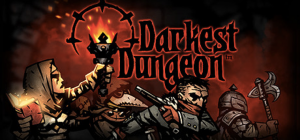
Cover Image
Game’s steam page: http://store.steampowered.com/app/262060/
What is it about?
The Darkest Dungeon is a rogue-like dungeon crawler with turn-based combat. It features elements such as permanent death, punishing difficulty and promises a painful journey complicated by unforgiving dice rolls. Unlike other games, the Darkest Dungeon prides itself as a game with high learning curve and relentless obstacles which would put the average player off. That said, it naturally becomes popular among gamers who enjoy having the odds stacked against their favor.
The Darkest Dungeon is developed by an indie game developer Red Hook Studios and is playable on the Playstation 4, Playstation Vita and Linux platforms. It has received positive reviews and several award nominations. It has also managed to sell over one million copies.
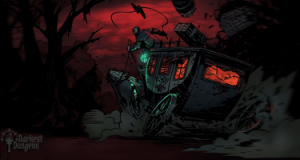
The world is painted with madness and despair
Lens of the Elemental Tetrad
The Darkest Dungeon harmonizes the four elements; aesthetics, story, mechanics and technology, well and stays true to its title throughout the player’s journey.
The story is simple but intriguing at the same time. Right off the bat, the aesthetics of the game is conveyed with an ominous barrage of organ music which reminds the player of the lovecrathian theme that the game is inspired by. Immediately after the prologue cinematic, the player is thrown into a dungeon and the feeling of forsaken and despair is aptly conveyed.
The mechanics of the game is seemingly simple. Visual cues are provided plentiful and the player can understand how the combat works without a wordy tutorial or intrusive markers and guided steps. Yet, the myriad of simple mechanics creates a comprehensive combat system which offers ample room for planning strategies and tactics to achieve victory. Therefore, the game notably achieved a simple to learn but difficult to master combat mechanic which made the game stay challenging and not outright impossible. This thus resonates well with the despair and anguish that the theme of the game tries to create.
Lastly, the technology of the game is more than sufficient. Although the game is entirely 2D, most of the combat mechanics are made more intuitive thanks to the 2D nature of the game. Without the need for 3D rendering, the game also benefited from quick load times, responsive gameplay and almost seamless progression throughout the dungeon. This offers the player no breaks from the grueling adventure. Thus, I felt that the technology used to create the game was both suitable and well justified.
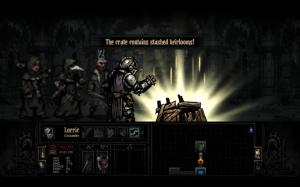
It is not always a treasure
Lens of Surprise
The gameplay of the Darkest Dungeon revolves around bringing parties of adventurers to explore the horrors around the game world and eventually exploring and conquering the darkest dungeon in the end. However, besides the type of area and objective of the dungeon run, the game gives no additional information of the dungeon. It is up to the player to take the gamble to prepare what the player thinks to be sufficient to complete and survive the dungeon. Encounters within the dungeon are also randomly generated and even the “loot” in the dungeon are mostly complicated by a chance of a negative outcome. This constant element of surprise keeps the player on his toes as he would have to constantly analyze his choices and adapt to the ever-changing odds as he progresses through the dungeon.
Moreover, the monsters that lurks in the various dungeons are well varied and each new encounter is packed with surprises as the monster unleashes a new combat pattern which the player would be caught off guard by and must adapt to its strategy ad hoc.
The purposeful deny of information to the player is done adequately to maintain the surprise factor of each combat encounter and at the same time, not impair the player to the point where he is left to poke in the dark, with no ability of devising any form of strategy.
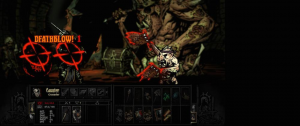
That moment when you want to rage quit
Lens of Balance
The Darkest Dungeon revolves greatly around the concept of chance. Strategies may fail if a series of unfortunate events happen to befall on the player and due to the long game length of around 80 hours, the player is bound of experience some of those occurrences of bad luck. As the game loves to stack the odds against the player, I feel that the player is always taking huge risks when making choices and is given no alternatives.
Since the game artificially raises the difficulty of the game by forcing the player to take risky gambles, I felt that the game was not well balanced. The Darkest Dungeon boasts many different adventurer archetypes and a fair bit of them are frowned upon due to their abilities relying largely on chance. That said, it could also be a deliberate design choice to introduce the element of uncertainty to the game, but I felt that it could have been better balanced.
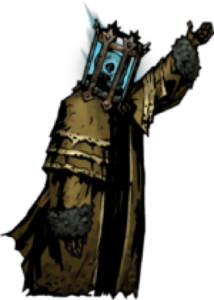
He visits you in the worst occasions.
Lens of Imagination
The game stays true to the lovecrathian theme by presenting its own representation of the eldritch horrors the lurks throughout the realm of the Darkest Dungeon. Dungeons are occasionally littered with notes which serves as fragments of story about past adventurers and their mishaps. These notes sometimes foreshadow future monsters and events that would happen in the game but is sure to omit certain details to let the player’s imagination run wild before witnessing the horrors themselves.
Additionally, the game’s narrator would inform the player about the lore behind the realm with his excellent voice overs which adds plenty of flavor to the player’s own interpretation of the lore behind the game world.
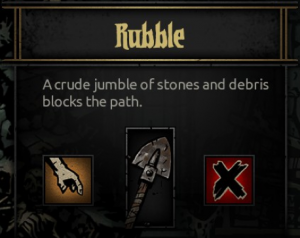
There was never a shortage of obstacles.
Lens of the Obstacle
Lastly, the game goes all out to design obstacles for the player such that the game would remain ever challenging or worse regardless of whether the player had advanced far in the game. The game is designed such that highly experienced adventurers would refuse to take on easier dungeons. Additionally, adventurers who are stressed by the horrors of their previous dungeon would carry over, discouraging the player from bringing the same adventurer on consecutive dungeons. There are more complications introduced to the player and all of them ensures that the player would not have an easy time. Therefore, when the player completes a dungeon, he will always enjoy a huge sense of relief and this makes each dungeon run appear to be not as monotonous and repetitive as it would have been otherwise.
